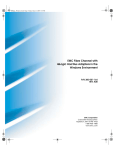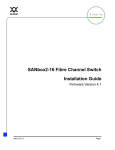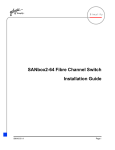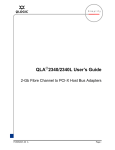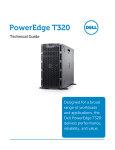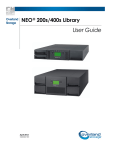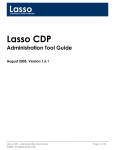Download QLogic SAN Configuration Guide for IBM Storage
Transcript
v4 02 06 About QLogic QLogic is the leading supplier of Fibre Channel host bus adapters (HBAs), blade server embedded Fibre Channel switches and Fibre Channel stackable switches. The Company is also a leading supplier of iSCSI HBAs. QLogic products are delivered to small, medium and large enterprises around the world, powering solutions from leading companies like Cisco, Dell, EMC, HP, IBM, NEC, Network Appliance and Sun Microsystems. QLogic is a member of the S&P 500 Index and NASDAQ 100 Index. For more information, visit www.qlogic.com. v4 Recent accolades include: • NASDAQ 100 Index • S&P 500 • Forbes' Best 200 Best Small Companies • Fortune's 100 Fastest Growing Companies • Business Week Hot Growth Company • Network Computing Well Connected • 2005 Storage Magazine "SAN Product of the Year" • 2005 SANbox 5602 InfoStor and ASNP "Most Valuable Product Finalist" TM Corporate Headquarters QLogic Corporation 26650 Aliso Viejo Parkway Aliso Viejo, CA 92656 949.389.6000 Europe Headquarters QLogic (UK) LTD. Surrey Technology Centre 40 Occam Road Guildford Surrey GU2 7YG UK +440(0)1483 295825 SAN Configuration Guide IBM Storage SAN Configuration Guide IBM Storage SIMPLE LOW COST v4 02 06 SAN Configuration Guide IBM Storage 02 06 W W W. Q L O G I C . C O M QLOGIC PRESS SN0135530-00 REV D 2/06 SANS QLOGIC PRESS QLogic SAN Configuration Guide for IBM Storage Version 4.0 Copyright © 2003-2006 QLogic Corporation. All rights reserved. THE INFORMATION PROVIDED IN THIS DOCUMENT IS PROVIDED “AS IS” WITHOUT WARRANTY OF ANY KIND, INCLUDING ANY WARRANTY OF MERCHANTABILITY, FITNESS FOR A PARTICULAR PURPOSE, INTEROPERABILITY, OR COMPATIBILITY. All of the Partners' products are warranted in accordance with the agreements under which the warranties for the products are provided. Unless otherwise specified, the product manufacturer, supplier, or publisher of non-Partner products provides warranty, service, and support directly to you. THE PARTNERS MAKE NO REPRESENTATIONS OR WARRANTIES REGARDING THE PARTNERS PRODUCTS OR NON-PARTNER PRODUCTS AND NO WARRANTY IS PROVIDED FOR EITHER THE FUNCTIONALITY OR PROBLEM RESOLUTION OF ANY PRODUCTS. Within this document, “Partner” refers to QLogic and the other companies referenced herein who provide products or services that you may use along with QLogic products. These Partners include, but are not limited to, IBM, Brocade, McDATA, Sun, and Microsoft. The inclusion of the Partners' products on an interoperability list is not a guarantee that they will work with the other designated storage products. In addition, not all software and hardware combinations created from compatible components will necessarily function properly together. The Partners do not provide service or support for the non-Partner products listed, but does not prohibit them from being used together with their storage products. During problem debug and resolution, the Partners may require that hardware or software additions be removed from products to provide problem determination and resolution on the supplied hardware/software. For support issues regarding non-Partner products, please contact the manufacturer of the product directly. This information could include technical inaccuracies or typographical errors. The Partners do not assume any liability for damages caused by such errors as this information is provided “AS IS” for convenience only; the reader uses this information at its own risk, and should confirm any information contained herein with the associated vendor. Changes are periodically made to the content of this document. These changes will be incorporated in new editions of the document. The Partners may make improvements and/or changes in the product(s)and/or the program(s) described in this document at any time without notice. Any references in this information to non-Partner websites are provided for convenience only and do not in any manner serve as an endorsement of those websites. The materials at those websites are not part of the materials for this Interoperability Guide and the use of those websites is at your own risk. Information concerning non-Partner products was obtained from the suppliers of those products, their published announcements, or other publicly available sources. The Partners have not tested those products and cannot confirm the accuracy of performance, compatibility, or any other claims related to those products. Questions about the capabilities of non-Partner products should be addressed to the suppliers of those products. All statements regarding the Partners' future direction or intent are subject to change or withdrawal without notice, and represent goals and objectives only. This information is only for planning purposes, any use of the information contained herein is at the user's sole risk. The information herein is subject to change before the products described become available. QLogic, the QLogic logo, SANblade, SANbox, SANbox2 and SANtrack are trademarks or registered trademarks of QLogic Corporation in the United States, other countries, or both. IBM, the IBM logo, TotalStorage Proven, and the TotalStorage Proven logo are trademarks or registered trademarks of International Business Machines Corporation in the United States, other countries, or both. Brocade, the Brocade logo, and Silkworm are trademarks or registered trademarks of Brocade Communications Systems, Inc. in the United States, other countries, or both. McDATA, the McDATA logo, and Sphereon are trademarks or registered trademarks of McDATA Corporation in the United States, other countries, or both. Sun, Sun Microsystems, the Sun logo, Solaris, Sun Management Center, and Sun StorEdge are trademarks or registered trademarks of Sun Microsystems, Inc. in the United States, other countries, or both Microsoft is a trademark or registered trademark of Microsoft corporation in the United States, other countries, or both. QLogic Corporation 26650 Aliso Viejo Parkway Aliso Viejo, CA 92656 Phone: (949) 389-6000 or (800) 662-4471 Fax: (949) 389-6009 Table of Contents Introduction ............................................................................................................... 9 Statement of Support ............................................................................................. 11 Test Philosophy ...................................................................................................... 13 Application-Level Interoperability Test..................................................................................... 13 Device-Level Interoperability ..................................................................................................... 13 Server Interoperability ............................................................................................................ 13 Storage Interoperability .......................................................................................................... 13 Application Device-Level Interoperability................................................................................ 13 Tested SAN Configurations ....................................................................................................... 14 Single-Switch Configuration: SANbox2-64 ............................................................................. 14 Cascade Configuration: SANbox 5200 ................................................................................... 15 Cascade Configuration: SANbox 5602 and SANbox 5200..................................................... 15 Cascade Configuration: SANbox2-64 and SANbox5602 ...................................................... 16 Cascade Configuration: SANbox2-64 with SANbox2-64 ........................................................ 16 Cascade Configuration: SANbox 5000 Series and McDATA 4500 ........................................ 17 Cascade Configuration: SANbox 5000 Series and Brocade 3850 ......................................... 17 SVC Configuration.................................................................................................................. 18 Driver and Firmware Levels ................................................................................... 19 QLogic SANblade HBAs ............................................................................................................. 19 Switches....................................................................................................................................... 19 IBM Storage ................................................................................................................................. 20 Application Software / Appliances ............................................................................................ 20 Operating Systems ..................................................................................................................... 20 Libraries and Tape Drives .......................................................................................................... 20 SAN Setup and Configuration .............................................................................. 21 Server Configuration .................................................................................................................. 22 Fibre Channel HBAs Overview ............................................................................................... 22 Assumptions ........................................................................................................................... 22 QLOGIC SAN CONFIGURATION GUIDE FOR IBM STORAGE VERSION 4.0, FEBRUARY 2006 PAGE 5 Table of Contents Configuring the Server on Windows ....................................................................................... 23 Installing SANsurfer Management Suite .......................................................................... 23 Installing the Windows Driver........................................................................................... 29 Configuring the HBA on Windows.................................................................................... 34 Configuring the Server on Red Hat ........................................................................................ 38 Installing SANsurfer Pro................................................................................................... 38 Installing the Red Hat Driver ............................................................................................ 42 Configuring the HBA ........................................................................................................ 43 Storage Configuration ................................................................................................................ 47 IBM Storage Overview............................................................................................................ 47 Disk Storage Systems Configuration........................................................................................ 48 Assumptions ........................................................................................................................... 48 Configuration Steps ................................................................................................................ 48 Creating a Host ................................................................................................................ 49 Creating a Rank .............................................................................................................. 56 Creating An Extent Pool................................................................................................... 61 Creating Volumes............................................................................................................. 67 Create Volume Groups .................................................................................................... 73 Enterprise Storage Server (ESS) Configuration....................................................................... 78 Assumptions ........................................................................................................................... 78 Configuration Steps ................................................................................................................ 78 Opening the ESS Specialist Management Application .................................................... 79 Configuring Disk Groups .................................................................................................. 82 Configuring the Port Type ................................................................................................ 84 Defining the Host System................................................................................................. 86 Adding Volumes ............................................................................................................... 88 Changing Volume Assignments ....................................................................................... 93 FAStT Configuration ................................................................................................................... 96 Assumptions ........................................................................................................................... 96 Configuring the FAStT 900 ..................................................................................................... 96 Discovering FAStT 900 Devices ..................................................................................... 97 Assigning Device Names ................................................................................................. 98 Creating a RAID Group and Logical Drives ................................................................... 100 Mapping Logical Drives to Hosts and Ports ................................................................... 107 PAGE 6 QLOGIC SAN CONFIGURATION GUIDE FOR IBM STORAGE VERSION 4.0, FEBRUARY 2006 Table of Contents Configuring the FAStT 200 ................................................................................................... 113 Discovering FAStT 200 Devices .................................................................................... 113 Assigning a Device Name .............................................................................................. 115 Creating a RAID Group and Logic Drives ...................................................................... 116 Storage Network Configuration ............................................................................................... 123 Fibre Channel Switches from QLogic ................................................................................... 123 SANbox 5000 Series Stackable Switches...................................................................... 123 SANbox Express 1400 Switch ....................................................................................... 123 SANbox2-64 Switches ................................................................................................... 123 Configuration Process .......................................................................................................... 123 Installing the SANsurfer Switch Manager ............................................................................. 124 Initial Switch Configuration ................................................................................................... 128 Command Line Configuration ........................................................................................ 136 Switch-Specific Configuration Steps .............................................................................. 137 SANbox 5000 Series and SANbox Express 1400 Configuration .......................................... 138 SANbox 5000 Series Port Properties ................................................................................... 138 SANbox Express 1400 Port Properties ................................................................................ 142 Connecting Cables ............................................................................................................... 146 Configuring Zones ................................................................................................................ 148 Activating the Zone Set Manually................................................................................... 154 SANbox2-64 Configuration ...................................................................................................... 157 Configuring Port Properties .................................................................................................. 157 Connecting Cables ............................................................................................................... 161 Configuring Zones ................................................................................................................ 162 Activating the Zone Set Manually................................................................................... 168 Index....................................................................................................................... 171 QLogic Press Review ........................................................................................... 175 QLogic Company Information ............................................................................. 177 QLOGIC SAN CONFIGURATION GUIDE FOR IBM STORAGE VERSION 4.0, FEBRUARY 2006 PAGE 7 Table of Contents PAGE 8 QLOGIC SAN CONFIGURATION GUIDE FOR IBM STORAGE VERSION 4.0, FEBRUARY 2006 Introduction The QLogic SAN Configuration Guide for IBM Storage is a comprehensive resource for developers and consultants interested in deploying QLogic solutions. How to Use This Guide This guide provides detailed solution configurations and interoperability information, which allow you to deploy a QLogic-powered SAN. Updated versions of this guide can be downloaded from the QLogic website at: http://www.qlogic.com/interopguide. End-to-end interoperability not only includes switches, host bus adapters (HBAs), and storage products; it also extends to the component level. Therefore, this guide includes detailed information outlining the exact configurations tested by QLogic and the procedures necessary to deploy a SAN. For More Information Over 50 million QLogic products have shipped inside servers, workstations, RAID subsystems, tape libraries, disk and tape drives. Powering solutions from the industry’s leading storage network providers, the broad line of QLogic controller chips, HBAs, storage network switches and management software move data from storage devices through the network fabric to servers. Additional QLogic resources can be found at the following locations: Fibre Channel Host Bus Adapters http://www.qlogic.com/products/fc_san_hostadapers.asp Fibre Channel Switches http://www.qlogic.com/products/fc_san_switchs.asp QLogic Technical Support http://www.qlogic.com/support/ Interoperability Guides from QLogic Press http://www.qlogic.com/interopguide/ QLOGIC SAN CONFIGURATION GUIDE FOR IBM STORAGE VERSION 4.0, FEBRUARY 2006 PAGE 9 Introduction PAGE 10 QLOGIC SAN CONFIGURATION GUIDE FOR IBM STORAGE VERSION 4.0, FEBRUARY 2006 Statement of Support The QLogic SAN Pro™ Service and Support Program allows customers to choose from a variety of service plans designed to meet specific business requirements. SAN Pro covers a diverse range of services, including remote technical assistance, on-site support and advanced hardware replacement. Best of all, no matter which plan is selected, customer satisfaction is guaranteed by QLogic and its network of authorized service partners. QLogic switch products allow a wide range of organizations to exploit the power of a SAN. Whether it's a fast growing small firm implementing a network with 10-20 devices, or a Fortune 100 Corporation creating a large infrastructure with thousands of devices, the QLogic SAN Pro Service and Support Program effectively addresses your needs. The SAN Pro Service and Support Program offers a diverse range of services including SAN Pro Prime, SAN Pro Select, and SAN Pro Exchange. Customers may choose among the services that best meet the demands of their business. Most importantly, customers are assured complete satisfaction since QLogic and its qualified partners fully guarantee all products and services. For additional information on support, please visit QLogic at: http://support.qlogic.com/support/warranty_expertlink.asp. For warranty information, please visit QLogic at http://support.qlogic.com/support/warranty.asp. QLOGIC SAN CONFIGURATION GUIDE FOR IBM STORAGE VERSION 4.0, FEBRUARY 2006 PAGE 11 Statement of Support PAGE 12 QLOGIC SAN CONFIGURATION GUIDE FOR IBM STORAGE VERSION 4.0, FEBRUARY 2006 Test Philosophy The QLogic SAN configuration test philosophy is broken down into two test levels: Application-level interoperability Device-level interoperability Application-Level Interoperability Test The application-level interoperability test ensures that applications such as backup/restore, LAN-free back-up, serverless backup, and server clustering will run as designed on a combinations of hardware components that are representative of customer configurations. At this level, the hardware configurations are, for the most part, complex and can involve numerous devices that differ by type, vendor and operating system. Since the objective of this test is to determine the feasibility of typical customer SAN solutions, not every function of the application can be tested. While the application-level interoperability test addresses the major functions of the application, successful completion of the test does not guarantee full interoperability. However, it does provide a reasonably high level of confidence that the application will function well in most SAN solution scenarios. Device-Level Interoperability The device-level and system integration test verifies functionality of the device with additional hardware and software. The interoperability and system integration test ensures conformance with the ANSI Fibre Channel (FC) standards and interoperability between servers and storage. Server Interoperability This ensures there are no problems between the HBA and the server. Potential problems, which may be found in this testing, include incompatibility between the HBA and server PCI chipsets, and conflicts between the HBA driver/BIOS setting and drivers/BIOS setting of other installed devices/adapters in the server. Storage Interoperability Storage devices such as disk arrays and tape devices are tested with SAN hardware and HBAs. This ensures compatibility between the end device and SAN hardware. Potential problems that may be found include improper LIP handling, AL_PA and Worldwide Name problems, jitter, and so on. Application Device-Level Interoperability The application device-level interoperability test ensures coexistence with the operating system environment and typical user shrink-wrapped software. It also ensures that the software works with the applicable hardware. In the case of a Windows environment, the component should have successfully completed all applicable Microsoft Hardware Certification program tests. QLOGIC SAN CONFIGURATION GUIDE FOR IBM STORAGE VERSION 4.0, FEBRUARY 2006 PAGE 13 Tested SAN Configurations Single-Switch Configuration: SANbox2-64 Tested SAN Configurations The following SAN illustrations show several different configurations and components certified by QLogic. Your configuration details may differ. NOTE: For information on multi-vendor switch configuration, please see the Switch Interoperability Guide at http://www.qlogic.com/interopguide. Single-Switch Configuration: SANbox2-64 IBM DS8100, ESS, or FAStT SANbox2-64 W2K / W2K3 / Linux QLA23xx / QLE246x Tape Library PAGE 14 QLOGIC SAN CONFIGURATION GUIDE FOR IBM STORAGE VERSION 4.0, FEBRUARY 2006 Tested SAN Configurations Cascade Configuration: SANbox 5200 Cascade Configuration: SANbox 5200 IBM DS8100, ESS, or FAStT SANbox 5200 W2K / W2K3 / Linux QLA23xx / QLE246x Tape Library Cascade Configuration: SANbox 5602 and SANbox 5200 IBM DS8100, ESS, or FAStT SANbox 5602 W2K / W2K3 / Linux QLA23xx / QLE246x Tape Library SANbox 5200 QLOGIC SAN CONFIGURATION GUIDE FOR IBM STORAGE VERSION 4.0, FEBRUARY 2006 PAGE 15 Tested SAN Configurations Cascade Configuration: SANbox2-64 and SANbox5602 Cascade Configuration: SANbox2-64 and SANbox5602 IBM DS8100, ESS, or FAStT SANbox2-64 W2K / W2K3 / Linux QLA23xx / QLE246x Tape Library SANbox 5602 Cascade Configuration: SANbox2-64 with SANbox2-64 IBM DS8100, ESS, or FAStT SANbox2-64 W2K / W2K3 / Linux QLA23xx / QLE246x Tape Library SANbox2-64 PAGE 16 QLOGIC SAN CONFIGURATION GUIDE FOR IBM STORAGE VERSION 4.0, FEBRUARY 2006 Tested SAN Configurations Cascade Configuration: SANbox 5000 Series and McDATA 4500 Cascade Configuration: SANbox 5000 Series and McDATA 4500 IBM DS8100, ESS, or FAStT SANbox 5000 Series W2K / W2K3 / Linux QLA23xx / QLE246x Tape Library McDATA 4500 Cascade Configuration: SANbox 5000 Series and Brocade 3850 IBM DS8100, ESS, or FAStT SANbox 5000 Series W2K / W2K3 / Linux QLA23xx / QLE246x Tape Library Brocade 3850 QLOGIC SAN CONFIGURATION GUIDE FOR IBM STORAGE VERSION 4.0, FEBRUARY 2006 PAGE 17 Tested SAN Configurations SVC Configuration SVC Configuration W2K / W2K3 / Linux QLA23xx / QLE246x SVC Node SVC Node QLogic 5200 QLogic 5600 DS4100 Storage ESS 2105 PAGE 18 QLOGIC SAN CONFIGURATION GUIDE FOR IBM STORAGE VERSION 4.0, FEBRUARY 2006 Driver and Firmware Levels The following driver and firmware levels were used during QLogic certification testing. As new levels of software are released, they will be supported. See the QLogic website for the latest drivers, software, and manuals: http://www.qlogic.com/support/drivers_software.asp. QLogic SANblade HBAs Model Windows 2003 Driver Windows 2000 Driver BIOS Linux Red Hat Driver QLA2310 8.2.3.11 or above 8.2.3.11 or above 1.29 or above 6.06.10 QLA2340 8.2.3.11 or above 8.2.3.11 or above 1.29 or above 6.06.10 QLA2342 8.2.3.11 or above 8.2.3.11 or above 1.29 or above 6.06.10 QLE2460 9.1.0.16 (w32) or above 9.1.0.11 or above 1.29 or above 7.07.01 QLE2462 9.1.0.16 (w32) or above 9.1.0.11 or above 1.29 or above 7.07.01 NOTE: To download the latest IBM-approved HBA drivers, please see the QLogic website at: http://www.qlogic.com/support/oem_detail_all.asp?oemid=22. Switches Manufacturer Model Firmware QLogic SANbox 5602 5.0.0.17 or above QLogic SANbox 5600 5.0.0.27 or above QLogic SANbox 5200 5.0.0.17 or above QLogic SANbox Express 1400 5.0.0.17 or above QLogic SANbox2-64 5.0.0.17 or above McDATA Sphereon 4500 6.02 or above McDATA Sphereon 4300 6.02 or above McDATA Intrepid 6.02 or above Brocade Silkworm 24000 4.4.0e Brocade Silkworm 12000 4.4.0e Brocade Silkworm 3900 4.1.2f Brocade Silkworm 3850 4.1.2f Brocade Silkworm 3250 4.1.2f QLOGIC SAN CONFIGURATION GUIDE FOR IBM STORAGE VERSION 4.0, FEBRUARY 2006 PAGE 19 Driver and Firmware Levels IBM Storage Model Firmware DS8100 Model 2107 5.0.3.0277 DS6800 Model 1750 5.0.3.0264c DS4100 Model 1724 5.42.03.00 ESS 2105-800 (Shark) 2.4.0.245 FAStT 200 05.30 FAStT 900 06.12 Application Software / Appliances Application Vendor Version SANsurfer™ Management Suite CD QLogic 5.00.05 or above SANbox® Manager QLogic 5.00.05 or above SANblade™ Manager QLogic 5.00.05 or above DS8000 Storage Manager IBM 5.0.3.0277 or above SVC (SAN Virtualization Controller) Model 2145 IBM 2.1.0.2 or above FAStT Storage Manager IBM 07.10.G5.14 or above Operating Systems Operating System Version Service Pack/Kernel Microsoft Windows 2000 Server SP4 or above Microsoft Windows 2003 Server SP1 or above Red Hat Linux Advanced Server 3.0 2.4.21-27 Libraries and Tape Drives Manufacturer * Model Microcode IBM ULT3582-TL Library 227B or above IBM ULT3580-TD1 Tape Drive 38D0 or above IBM LTO 3 54K1 or above STK L 180 Tape Library 3.09.00 or above * These libraries and tape drives were tested during QLogic certification but procedures are not available. Please check with your tape or library vendor representative for more information. PAGE 20 QLOGIC SAN CONFIGURATION GUIDE FOR IBM STORAGE VERSION 4.0, FEBRUARY 2006 SAN Setup and Configuration The following section of the QLogic SAN Configuration Guide for IBM Storage provides instructions to set up and configure your servers, storage, and storage network. Once you have completed these steps, additional procedures illustrate how to connect the host and storage ports to the networks, and how to validate your storage network connections. In most cases, the SAN setup and configuration proceeds in this order: 1. Server Configuration 2. Storage Configuration 3. Storage Network Configuration QLOGIC SAN CONFIGURATION GUIDE FOR IBM STORAGE VERSION 4.0, FEBRUARY 2006 PAGE 21 Server Configuration Fibre Channel HBAs Overview Server Configuration This section walks you through the steps needed to ready your server for connection to the storage network, including information on: Installing the HBA and switch device management application (SANsurfer Management Suite) Installing and configuring HBA drivers Configuring the HBA with appropriate settings To complete the server configuration, refer to the appropriate section: Configuring the Server on Windows Configuring the Server on Red Hat Fibre Channel HBAs Overview The award-winning QLogic SANblade 2300 Series Fibre Channel HBAs offer 2Gbps performance for demanding SANs and are available in PCI-X form factor, which is backwards compatible to PCI. QLogic SANblade HBAs are the industry's highest-performing and most widely deployed host adapter solutions for server, networking, storage and clustering solutions. The SANblade 2300 Series architecture is the result of more than 15 years of progressive development and testing. The QLogic proven architecture delivers higher overall reliability and enables advanced functionality with its single chip integration, placing QLogic years ahead of its competitors. The SANblade 2300 also has proven interoperability with all major software applications, hardware platforms and operating systems. The SANblade QLE2460 and QLE2462 Fibre Channel HBAs offer enterprise-class 4Gbps performance in a PCI-E form factor with dual- (2462) and single-port (2460) options. The QLogic SANblade HBAs tested with the IBM storage systems are: QLA234x QLA2310 QLE2460 QLE2462 Assumptions The following procedures assume that: You have installed the HBA device into the system according to specifications in the hardware installation guide provided with the HBA. For more information, see the SANblade user manual at: http://www.qlogic.com/support/home_resources.asp?id=76. Your operating system and appropriate patches have been installed to meet the software and driver requirements for all components. For more information, see “Driver and Firmware Levels” on page 19. PAGE 22 QLOGIC SAN CONFIGURATION GUIDE FOR IBM STORAGE VERSION 4.0, FEBRUARY 2006 Server Configuration Configuring the Server on Windows Configuring the Server on Windows The following sections describe the server configuration steps for Windows: Installing SANsurfer Management Suite Installing the Windows Driver Configuring the HBA on Windows Installing SANsurfer Management Suite To install the SANsurfer Management Suite, follow these steps: NOTE: You can use this version of the SANsurfer Management Suite only for HBA configuration. A different version of the SANsurfer Switch Manager is required to configure your QLogic Fibre Channel switches. (Refer to “Installing the SANsurfer Switch Manager” on page 72.) 1. Download the latest version from the Download section of the QLogic website (http://www.qlogic.com/support/drivers_software.asp) and double click the icon to start the installation. 2. When the Introduction dialog displays, click Next. 3. Read the Application Notes carefully and click Next when you’re ready: QLOGIC SAN CONFIGURATION GUIDE FOR IBM STORAGE VERSION 4.0, FEBRUARY 2006 PAGE 23 Server Configuration Configuring the Server on Windows 4. PAGE 24 Select ALL GUIs and ALL Agents and click Next. QLOGIC SAN CONFIGURATION GUIDE FOR IBM STORAGE VERSION 4.0, FEBRUARY 2006 Server Configuration Configuring the Server on Windows 5. Edit the path where you want to install the software or click Choose and browse to the location. Click Next: b QLOGIC SAN CONFIGURATION GUIDE FOR IBM STORAGE VERSION 4.0, FEBRUARY 2006 PAGE 25 Server Configuration Configuring the Server on Windows 6. PAGE 26 Select the Shortcut Profile you wish to use and click Next: QLOGIC SAN CONFIGURATION GUIDE FOR IBM STORAGE VERSION 4.0, FEBRUARY 2006 Server Configuration Configuring the Server on Windows 7. On Windows only, check create desktop icon if you wish, and click Next: QLOGIC SAN CONFIGURATION GUIDE FOR IBM STORAGE VERSION 4.0, FEBRUARY 2006 PAGE 27 Server Configuration Configuring the Server on Windows 8. PAGE 28 Review the Pre-Installation Summary and click Install when you’re ready: QLOGIC SAN CONFIGURATION GUIDE FOR IBM STORAGE VERSION 4.0, FEBRUARY 2006 Server Configuration Configuring the Server on Windows 9. When the Default QLogic Failover Enable/Disable dialog box displays, click Next. NOTE: This feature may be enabled through SANsurfer Management Suite at a later date. 10. Click Done when the installation process completes. Installing the Windows Driver The QLA23xx HBAs are plug-and-play devices automatically detected by Windows. 1. Download the latest driver from the Download section of the QLogic website (http://www.qlogic.com/support/drivers_software.asp) and extract them. 2. Windows detects the newly installed device, then displays the Found New Hardware Wizard message. Click Next to begin the driver installation. QLOGIC SAN CONFIGURATION GUIDE FOR IBM STORAGE VERSION 4.0, FEBRUARY 2006 PAGE 29 Server Configuration Configuring the Server on Windows 3. PAGE 30 When prompted, select Search for a suitable driver for my device (recommended) and click Next. QLOGIC SAN CONFIGURATION GUIDE FOR IBM STORAGE VERSION 4.0, FEBRUARY 2006 Server Configuration Configuring the Server on Windows 4. Check Specify a location and click Next: 5. Browse to the directory containing the driver and click OK: QLOGIC SAN CONFIGURATION GUIDE FOR IBM STORAGE VERSION 4.0, FEBRUARY 2006 PAGE 31 Server Configuration Configuring the Server on Windows 6. When the Driver Files Search Results display, click Next: 7. Click Finish to complete the installation. Windows 2000 HBA Pseudo LUN Driver For Windows 2000 only, you must also install the pseudo LUN driver. Windows 2000 detects the newly installed device automatically. 1. Click Next to begin the driver installation from the Found New Hardware Wizard message. 2. When prompted, select Search for a suitable driver for my device (recommended) and click Next. 3. Check Specify a location and click Next. 4. Browse to the directory containing the driver and click OK. PAGE 32 QLOGIC SAN CONFIGURATION GUIDE FOR IBM STORAGE VERSION 4.0, FEBRUARY 2006 Server Configuration Configuring the Server on Windows 5. When the Driver Files Search Results display, click Next: 6. Click Finish to complete the installation. QLOGIC SAN CONFIGURATION GUIDE FOR IBM STORAGE VERSION 4.0, FEBRUARY 2006 PAGE 33 Server Configuration Configuring the Server on Windows Configuring the HBA on Windows To configure the QLogic HBA on Windows, follow these steps: 1. Launch SANsurfer. 2. From the SANsurfer FC HBA Manager, click Connect on the toolbar: PAGE 34 QLOGIC SAN CONFIGURATION GUIDE FOR IBM STORAGE VERSION 4.0, FEBRUARY 2006 Server Configuration Configuring the Server on Windows 3. From the Connect to Host dialog, select the host from the list and click Connect: 4. When prompted to start the configuration wizard, click No: QLOGIC SAN CONFIGURATION GUIDE FOR IBM STORAGE VERSION 4.0, FEBRUARY 2006 PAGE 35 Server Configuration Configuring the Server on Windows 5. In the FC HBA list on the left, select the adapter to configure and click the Settings tab. 6. Choose the following settings to configure the adapter: a. Select the connection type from the Connections Options list. b. Select the connection speed from the Data Rate list. c. Check Enable Fibre Channel Tape Support. 7. PAGE 36 Click Save. QLOGIC SAN CONFIGURATION GUIDE FOR IBM STORAGE VERSION 4.0, FEBRUARY 2006 Server Configuration Configuring the Server on Windows 8. Enter the Password in the Security Check dialog box: NOTE: The default password is "config”. Contact your System Administrator if the password was changed. 9. Click OK to close the NVRAM Save confirmation message: QLOGIC SAN CONFIGURATION GUIDE FOR IBM STORAGE VERSION 4.0, FEBRUARY 2006 PAGE 37 Server Configuration Configuring the Server on Red Hat Configuring the Server on Red Hat The following sections describe how to configure the server on Red Hat: Installing SANsurfer Pro Installing the Red Hat Driver Configuring the HBA Installing SANsurfer Pro To install the SANsurfer Pro, follow these steps: NOTE: You can use this version of the SANsurfer Pro only for HBA configuration. A different version of the SANsurfer Switch Manager may be required to configure your QLogic Fibre Channel switches. (Refer to “Installing the SANsurfer Switch Manager” on page 72.) 1. Download the latest version from the Download section of the QLogic website (http://www.qlogic.com/support/drivers_software.asp) and double click the icon to start the installation. 2. When the Introduction dialog displays, click Next. 3. Read the Important Information carefully and click Next when you’re ready: PAGE 38 QLOGIC SAN CONFIGURATION GUIDE FOR IBM STORAGE VERSION 4.0, FEBRUARY 2006 Server Configuration Configuring the Server on Red Hat 4. Select ALL GUIs and ALL Agents and click Next. QLOGIC SAN CONFIGURATION GUIDE FOR IBM STORAGE VERSION 4.0, FEBRUARY 2006 PAGE 39 Server Configuration Configuring the Server on Red Hat 5. PAGE 40 Edit the path where you want to install the software or click Choose and browse to the location. Click Next: QLOGIC SAN CONFIGURATION GUIDE FOR IBM STORAGE VERSION 4.0, FEBRUARY 2006 Server Configuration Configuring the Server on Red Hat 6. Review the Pre-Installation Summary and click Install when you’re ready: QLOGIC SAN CONFIGURATION GUIDE FOR IBM STORAGE VERSION 4.0, FEBRUARY 2006 PAGE 41 Server Configuration Configuring the Server on Red Hat 7. When the Default QLogic Failover Enable/Disable dialog box displays, click Next. NOTE: This feature may be enabled through SANsurfer Management Suite at a later date. 8. Click Done when the installation process completes. Installing the Red Hat Driver To install the Red Hat driver, follow these steps: 1. Download the latest drivers from the Download section of the QLogic website (http://www.qlogic.com/support/drivers_software.asp) and extract them. 2. Verify that you have the kernel source package installed: [root@localhost qlogic]# rpm -qa |grep kernel-source 3. Uncompress and extract the distribution file: [root@localhost qlogic]# tar zxvf qla2x00-v7.07.01-dist.tgz 4. Change to the directory where you extracted the distribution file: [root@localhost qlogic]# cd qlogic 5. Execute the "qlinstall" script to extract and install the driver: [root@localhost qlogic]# ./qlinstall PAGE 42 QLOGIC SAN CONFIGURATION GUIDE FOR IBM STORAGE VERSION 4.0, FEBRUARY 2006 Server Configuration Configuring the Server on Red Hat Configuring the HBA On Red Hat, follow these steps to configure the QLogic HBA: 1. Launch SANsurfer. 2. From the SANsurfer FC HBA Manager tab, click Connect: QLOGIC SAN CONFIGURATION GUIDE FOR IBM STORAGE VERSION 4.0, FEBRUARY 2006 PAGE 43 Server Configuration Configuring the Server on Red Hat 3. From the Connect to Host dialog, select the host from the list and click Connect. 4. From the SANsurfer FC HBA Manager window: a. Select the desired port from the tree in the left hand frame. b. Click the Settings tab. c. From the Connection Options list, select the connection type to use. PAGE 44 QLOGIC SAN CONFIGURATION GUIDE FOR IBM STORAGE VERSION 4.0, FEBRUARY 2006 Server Configuration Configuring the Server on Red Hat d. Select a Data Rate from the list. e. Click Save. 5. Enter the password in the Security Check dialog box. 6. Click OK to the NVRAM Save confirmation message. QLOGIC SAN CONFIGURATION GUIDE FOR IBM STORAGE VERSION 4.0, FEBRUARY 2006 PAGE 45 Server Configuration Configuring the Server on Red Hat PAGE 46 QLOGIC SAN CONFIGURATION GUIDE FOR IBM STORAGE VERSION 4.0, FEBRUARY 2006 Storage Configuration IBM Storage Overview Storage Configuration This section outlines configuration procedures for the following IBM TotalStorage™ products tested by QLogic: Disk Storage Systems Configuration Enterprise Storage Server (ESS) Configuration FAStT Configuration IBM Storage Overview The IBM TotalStorage Disk Storage systems include the mid-range DS4100 and the enterprise class DS6800 and DS8100. These systems offer scalable, high-performance storage for on demand environments. The IBM TotalStorage Enterprise Storage Server (ESS) provides high-speed disks and internal Serial Storage Architecture (SSA) disk paths for pipeline data movement. The IBM ESS is a third-generation Seascape disk storage system. The IBM TotalStorage FAStT Storage Server provides flexible solutions for workgroup and departmental servers that require an external storage. The FAStT uses a Fibre Channel host attachment with Fibre Channel drives. QLogic has tested the configurations described in this guide under the IBM TotalStorage Proven program, introduced by IBM to help customers identify storage solutions and configurations that have been pre-tested for interoperability. The IBM TotalStorage Proven program is one of IBM’s efforts to develop and deliver products and solutions that work together with third party products. For more information about the IBM storage solutions, refer to the IBM website at the following addresses: Disk Storage Systems Product Information http://www-03.ibm.com/servers/storage/disk/index.html ESS Product Information http://www-03.ibm.com/servers/storage/disk/ess/ FAStT Product Information http://www-03.ibm.com/servers/storage/disk/ds4000/ IBM Storage Proven Program http://www-03.ibm.com/servers/storage/proven/index.html QLOGIC SAN CONFIGURATION GUIDE FOR IBM STORAGE VERSION 4.0, FEBRUARY 2006 PAGE 47 Disk Storage Systems Configuration Assumptions Disk Storage Systems Configuration The following sections illustrate how to configure the IBM TotalStorage DS8100 model. The configuration steps may also be used for the DS6800 and DS4100 models. Assumptions Configuration Steps Assumptions The configuration procedures assume that: You have allocated storage space of suitable size for the application being used. You have created and defined a RAID group within the storage. Your storage system has an available port. Configuration Steps Completing these steps as outlined on the following pages will prepare the allocated storage for connection to the fabric: Creating a Host Creating a Rank Creating An Extent Pool Creating Volumes Create Volume Groups PAGE 48 QLOGIC SAN CONFIGURATION GUIDE FOR IBM STORAGE VERSION 4.0, FEBRUARY 2006 Disk Storage Systems Configuration Configuration Steps Creating a Host 1. From the Welcome page, click the Host systems: Real-time tab. 2. Choose the Select Action menu and click Create. QLOGIC SAN CONFIGURATION GUIDE FOR IBM STORAGE VERSION 4.0, FEBRUARY 2006 PAGE 49 Disk Storage Systems Configuration Configuration Steps 3. On the General host information page: a. From the Type list, select the type of host system where you will connect the LUNs. b. Enter a Nickname for the host. Entering a Description is optional. c. Click Next. PAGE 50 QLOGIC SAN CONFIGURATION GUIDE FOR IBM STORAGE VERSION 4.0, FEBRUARY 2006 Disk Storage Systems Configuration Configuration Steps 4. On the Define host ports page: a. Specify the number of ports to which you are attaching in the Quantity field. b. Select the port type from the Attachment Port Type. c. Click Next. QLOGIC SAN CONFIGURATION GUIDE FOR IBM STORAGE VERSION 4.0, FEBRUARY 2006 PAGE 51 Disk Storage Systems Configuration Configuration Steps 5. On the Define host WWPN page: a. Enter the WWPN for each of the host ports (Host Adapter WWPN). b. Click Add to add each entry to the list. c. Click OK when you have added the WWPN for all the host ports. PAGE 52 QLOGIC SAN CONFIGURATION GUIDE FOR IBM STORAGE VERSION 4.0, FEBRUARY 2006 Disk Storage Systems Configuration Configuration Steps 6. Highlight the storage image you want to use in the list on the left and click Add to select it. Click Next. QLOGIC SAN CONFIGURATION GUIDE FOR IBM STORAGE VERSION 4.0, FEBRUARY 2006 PAGE 53 Disk Storage Systems Configuration Configuration Steps 7. PAGE 54 Check the box next to the port through which the LUNs will be exported to the host and click OK: QLOGIC SAN CONFIGURATION GUIDE FOR IBM STORAGE VERSION 4.0, FEBRUARY 2006 Disk Storage Systems Configuration Configuration Steps 8. Verify that the configuration is correct and click Finish when you are ready. To change one of the settings, click Back and make the appropriate changes. QLOGIC SAN CONFIGURATION GUIDE FOR IBM STORAGE VERSION 4.0, FEBRUARY 2006 PAGE 55 Disk Storage Systems Configuration Configuration Steps Creating a Rank 1. From the Ranks: Real-time tab: a. Select the Storage Image you previously added to your host from the Select Storage Image menu. b. Click Create from the Select Action menu. PAGE 56 QLOGIC SAN CONFIGURATION GUIDE FOR IBM STORAGE VERSION 4.0, FEBRUARY 2006 Disk Storage Systems Configuration Configuration Steps 2. Check the corresponding box to select an array for the rank and click Next. QLOGIC SAN CONFIGURATION GUIDE FOR IBM STORAGE VERSION 4.0, FEBRUARY 2006 PAGE 57 Disk Storage Systems Configuration Configuration Steps 3. PAGE 58 On the Define rank properties page, select FB from the Storage Type menu and click Next: QLOGIC SAN CONFIGURATION GUIDE FOR IBM STORAGE VERSION 4.0, FEBRUARY 2006 Disk Storage Systems Configuration Configuration Steps 4. On the Select extent pool, do not select an extent pool and click Next. QLOGIC SAN CONFIGURATION GUIDE FOR IBM STORAGE VERSION 4.0, FEBRUARY 2006 PAGE 59 Disk Storage Systems Configuration Configuration Steps 5. PAGE 60 Verify the Rank configuration and click Finish when you are ready: QLOGIC SAN CONFIGURATION GUIDE FOR IBM STORAGE VERSION 4.0, FEBRUARY 2006 Disk Storage Systems Configuration Configuration Steps Creating An Extent Pool 1. Choose the Extent pools: Real-time tab. 2. From the Select Action menu select Create: QLOGIC SAN CONFIGURATION GUIDE FOR IBM STORAGE VERSION 4.0, FEBRUARY 2006 PAGE 61 Disk Storage Systems Configuration Configuration Steps 3. PAGE 62 On the Definition method page, select Create custom extent pool and click Next: QLOGIC SAN CONFIGURATION GUIDE FOR IBM STORAGE VERSION 4.0, FEBRUARY 2006 Disk Storage Systems Configuration Configuration Steps 4. On the Define properties page: a. Enter a Nickname for the extent pool. b. Select the Storage type, RAID type, and server from the respective lists. c. Click Next to continue. QLOGIC SAN CONFIGURATION GUIDE FOR IBM STORAGE VERSION 4.0, FEBRUARY 2006 PAGE 63 Disk Storage Systems Configuration Configuration Steps 5. PAGE 64 Check the Select box next to each rank you want to include in the extent pool and click Next when you are ready: QLOGIC SAN CONFIGURATION GUIDE FOR IBM STORAGE VERSION 4.0, FEBRUARY 2006 Disk Storage Systems Configuration Configuration Steps 6. Enter the percentage of storage you want to reserve and click Next to continue.: QLOGIC SAN CONFIGURATION GUIDE FOR IBM STORAGE VERSION 4.0, FEBRUARY 2006 PAGE 65 Disk Storage Systems Configuration Configuration Steps 7. PAGE 66 Verify that the information is correct and click Finish when you are ready. To change any of the settings, click Back instead. QLOGIC SAN CONFIGURATION GUIDE FOR IBM STORAGE VERSION 4.0, FEBRUARY 2006 Disk Storage Systems Configuration Configuration Steps Creating Volumes 1. Click on the Volumes - Open systems: Real-time tab. 2. From the Select Action menu, choose Create and click Go to begin: QLOGIC SAN CONFIGURATION GUIDE FOR IBM STORAGE VERSION 4.0, FEBRUARY 2006 PAGE 67 Disk Storage Systems Configuration Configuration Steps 3. PAGE 68 Select an extent pool and click Next: QLOGIC SAN CONFIGURATION GUIDE FOR IBM STORAGE VERSION 4.0, FEBRUARY 2006 Disk Storage Systems Configuration Configuration Steps 4. Select the desired Volume type from the list and click Next: QLOGIC SAN CONFIGURATION GUIDE FOR IBM STORAGE VERSION 4.0, FEBRUARY 2006 PAGE 69 Disk Storage Systems Configuration Configuration Steps 5. PAGE 70 Enter the number of volumes you want in the Quantity field and the size of each volume in the Size field. For example, 4 volumes with 194GB per volume. Click Next to continue: QLOGIC SAN CONFIGURATION GUIDE FOR IBM STORAGE VERSION 4.0, FEBRUARY 2006 Disk Storage Systems Configuration Configuration Steps 6. Create the nickname(s) for your volume(s) by specifying a Prefix and Suffix value. Click Next to continue: QLOGIC SAN CONFIGURATION GUIDE FOR IBM STORAGE VERSION 4.0, FEBRUARY 2006 PAGE 71 Disk Storage Systems Configuration Configuration Steps 7. PAGE 72 Verify that the information is correct and click Finish when you are ready. To change any of the settings, click Back instead. QLOGIC SAN CONFIGURATION GUIDE FOR IBM STORAGE VERSION 4.0, FEBRUARY 2006 Disk Storage Systems Configuration Configuration Steps Create Volume Groups 1. Click the Volume groups: Real-time tab. 2. From the Select Action menu, choose Create and click Go to begin: QLOGIC SAN CONFIGURATION GUIDE FOR IBM STORAGE VERSION 4.0, FEBRUARY 2006 PAGE 73 Disk Storage Systems Configuration Configuration Steps 3. PAGE 74 Enter a Nickname for the volume group and the host type properties. Click Next to continue: QLOGIC SAN CONFIGURATION GUIDE FOR IBM STORAGE VERSION 4.0, FEBRUARY 2006 Disk Storage Systems Configuration Configuration Steps 4. Select the host attachments for the volume group and click Next to continue: QLOGIC SAN CONFIGURATION GUIDE FOR IBM STORAGE VERSION 4.0, FEBRUARY 2006 PAGE 75 Disk Storage Systems Configuration Configuration Steps 5. PAGE 76 Select the volumes to include in the volume group and click Next to continue: QLOGIC SAN CONFIGURATION GUIDE FOR IBM STORAGE VERSION 4.0, FEBRUARY 2006 Disk Storage Systems Configuration Configuration Steps 6. Verify that the information is correct and click Finish when you are ready. To change any of the settings, click Back instead. QLOGIC SAN CONFIGURATION GUIDE FOR IBM STORAGE VERSION 4.0, FEBRUARY 2006 PAGE 77 Enterprise Storage Server (ESS) Configuration Assumptions Enterprise Storage Server (ESS) Configuration The following sections describe how to configure the IBM TotalStorage Enterprise Storage Server 800 model: Assumptions Configuration Steps Assumptions The following procedures assume that: You have allocated storage space of suitable size for the application being used. You have created and defined a RAID group within the storage. Your storage system has an available port. Configuration Steps Completing these steps will prepare the allocated ESS storage for connection to the fabric: Opening the ESS Specialist Management Application Configuring Disk Groups Configuring the Port Type Defining the Host System Adding Volumes Changing Volume Assignments PAGE 78 QLOGIC SAN CONFIGURATION GUIDE FOR IBM STORAGE VERSION 4.0, FEBRUARY 2006 Enterprise Storage Server (ESS) Configuration Configuration Steps Opening the ESS Specialist Management Application 1. Open Internet Explorer, enter the IP address of the ESS storage device in the address bar, and press Enter. 2. The IBM TotalStorage Solutions management application appears in the browser. Click ESS Specialist: QLOGIC SAN CONFIGURATION GUIDE FOR IBM STORAGE VERSION 4.0, FEBRUARY 2006 PAGE 79 Enterprise Storage Server (ESS) Configuration Configuration Steps 3. Enter the administrative User Name and Password: 4. From the ESS Specialist, click Storage Allocation: PAGE 80 QLOGIC SAN CONFIGURATION GUIDE FOR IBM STORAGE VERSION 4.0, FEBRUARY 2006 Enterprise Storage Server (ESS) Configuration Configuration Steps 5. From the Storage Allocation window, click Open System Storage: QLOGIC SAN CONFIGURATION GUIDE FOR IBM STORAGE VERSION 4.0, FEBRUARY 2006 PAGE 81 Enterprise Storage Server (ESS) Configuration Configuration Steps Configuring Disk Groups 1. PAGE 82 From the Open System Storage window, click Configure Disk Groups: QLOGIC SAN CONFIGURATION GUIDE FOR IBM STORAGE VERSION 4.0, FEBRUARY 2006 Enterprise Storage Server (ESS) Configuration Configuration Steps 2. From the Fixed Block Storage window: a. Select the Disk Group. b. Select a Storage Type from the list. c. Click Perform Configuration Update. QLOGIC SAN CONFIGURATION GUIDE FOR IBM STORAGE VERSION 4.0, FEBRUARY 2006 PAGE 83 Enterprise Storage Server (ESS) Configuration Configuration Steps Configuring the Port Type 1. From the Open System Storage window, click Configure Host Adapter Ports: 2. To configure the ports: a. Click one of the adapter icons located at the top of the window. b. Select the Fibre Channel Topology (Point to Point or Loop). PAGE 84 QLOGIC SAN CONFIGURATION GUIDE FOR IBM STORAGE VERSION 4.0, FEBRUARY 2006 Enterprise Storage Server (ESS) Configuration Configuration Steps c. Set the Fibre Channel Protocol to (FCP) Open Systems. d. Click Perform Configuration Update. QLOGIC SAN CONFIGURATION GUIDE FOR IBM STORAGE VERSION 4.0, FEBRUARY 2006 PAGE 85 Enterprise Storage Server (ESS) Configuration Configuration Steps Defining the Host System 1. From the Open System Storage window, click Modify Host Systems: 2. In the Modify Host Systems window, you can enter new host information or modify information for an existing host: a. In the Host Attributes list, enter a Nickname for the host and select a Host Type from the list. b. From the Host Attachment list, select Fibre Channel Attached and select the host’s WWPN from the World-Wide Port Name list. c. For the Fibre Channel Port, select the port configured in the previous section. PAGE 86 QLOGIC SAN CONFIGURATION GUIDE FOR IBM STORAGE VERSION 4.0, FEBRUARY 2006 Enterprise Storage Server (ESS) Configuration Configuration Steps d. Click Add to add a new host to the list or click Modify to add an existing host. e. Click Perform Configuration Update. QLOGIC SAN CONFIGURATION GUIDE FOR IBM STORAGE VERSION 4.0, FEBRUARY 2006 PAGE 87 Enterprise Storage Server (ESS) Configuration Configuration Steps Adding Volumes a. From the Open Storage System window, click Add Volumes: 3. In the window, Add Volumes (1 of 2): a. Scroll through the list of hosts and select the host previously defined. b. Select the desired adapter. A path will appear between the host and adapter. PAGE 88 QLOGIC SAN CONFIGURATION GUIDE FOR IBM STORAGE VERSION 4.0, FEBRUARY 2006 Enterprise Storage Server (ESS) Configuration Configuration Steps c. Select the desired non-allocated storage from the cluster you want. The legend in the upper right corner identifies assigned, unassigned, and not allocated storage. d. Click Next when finished. QLOGIC SAN CONFIGURATION GUIDE FOR IBM STORAGE VERSION 4.0, FEBRUARY 2006 PAGE 89 Enterprise Storage Server (ESS) Configuration Configuration Steps 4. In the window, Add Volumes (2 of 2): a. Select the RAID you wish to use under Available Free Space. b. Select a volume size under Volume Attributes. c. Choose the number of Volumes you wish to create at that size under Number of Volume and click Add. After you click Add the volumes will be shown under the New Volume dialog. PAGE 90 QLOGIC SAN CONFIGURATION GUIDE FOR IBM STORAGE VERSION 4.0, FEBRUARY 2006 Enterprise Storage Server (ESS) Configuration Configuration Steps d. Choose a method for Volume Placement. e. Click Perform Configuration Update. QLOGIC SAN CONFIGURATION GUIDE FOR IBM STORAGE VERSION 4.0, FEBRUARY 2006 PAGE 91 Enterprise Storage Server (ESS) Configuration Configuration Steps 5. PAGE 92 At the warning message, click Yes to confirm and wait for the update to complete. QLOGIC SAN CONFIGURATION GUIDE FOR IBM STORAGE VERSION 4.0, FEBRUARY 2006 Enterprise Storage Server (ESS) Configuration Configuration Steps Changing Volume Assignments 1. From the Open System Storage window, click Modify Volume Assignments: 2. From the Modify Volume Assignments window. a. Select the volume you want to assign. b. Choose Assign selected volume(s) to target hosts. QLOGIC SAN CONFIGURATION GUIDE FOR IBM STORAGE VERSION 4.0, FEBRUARY 2006 PAGE 93 Enterprise Storage Server (ESS) Configuration Configuration Steps c. Choose your target host under Target Hosts. d. Click Perform Configuration Update. PAGE 94 QLOGIC SAN CONFIGURATION GUIDE FOR IBM STORAGE VERSION 4.0, FEBRUARY 2006 Enterprise Storage Server (ESS) Configuration Configuration Steps 3. At the confirmation message, click OK: 4. This step completes your configuration. Close the browser window to exit the ESS management application. QLOGIC SAN CONFIGURATION GUIDE FOR IBM STORAGE VERSION 4.0, FEBRUARY 2006 PAGE 95 FAStT Configuration Assumptions FAStT Configuration The configuration process for the FAStT storage server models is very similar. However, the FAStT 200 and FAStT 900 use different versions of the Storage Manager application. Read the following sections to configure the FAStT: Assumptions Configuring the FAStT 900 Configuring the FAStT 200 Assumptions The following FAStT configuration procedures assume that: You have configured the FAStT with an IP address and connected to the LAN. You have installed the FAStT Storage Manager application required by your FAStT model as instructed in the vendor documentation. For version information, refer to “Application Software / Appliances” on page 20. You have allocated storage space of suitable size for the application being used. Your disks are available to create a RAID group. Your storage system has an available port. Configuring the FAStT 900 Completing these steps will prepare the allocated FAStT storage for connection to the fabric: Discovering FAStT 900 Devices Assigning Device Names Creating a RAID Group and Logical Drives Mapping Logical Drives to Hosts and Ports PAGE 96 QLOGIC SAN CONFIGURATION GUIDE FOR IBM STORAGE VERSION 4.0, FEBRUARY 2006 FAStT Configuration Configuring the FAStT 900 Discovering FAStT 900 Devices 1. Open the IBM FAStT Storage Manager Application. 2. From the Tools menu, select Automatic Discovery to discover your device(s): 3. Select OK to begin automatic discovery, which may take several minutes: The device(s) appears in the list. QLOGIC SAN CONFIGURATION GUIDE FOR IBM STORAGE VERSION 4.0, FEBRUARY 2006 PAGE 97 FAStT Configuration Configuring the FAStT 900 Assigning Device Names 1. Select the FAStT storage subsystem. 2. From the Tools menu, click Manage Device. PAGE 98 QLOGIC SAN CONFIGURATION GUIDE FOR IBM STORAGE VERSION 4.0, FEBRUARY 2006 FAStT Configuration Configuring the FAStT 900 3. From the Storage Subsystem menu, select Rename. 4. Enter a name for the Storage Subsystem and click OK. QLOGIC SAN CONFIGURATION GUIDE FOR IBM STORAGE VERSION 4.0, FEBRUARY 2006 PAGE 99 FAStT Configuration Configuring the FAStT 900 Creating a RAID Group and Logical Drives 1. From the Array menu, select Create Logic Drive: 2. From the drop down menu, choose the default host type you are connecting to the RAID controllers: PAGE 100 QLOGIC SAN CONFIGURATION GUIDE FOR IBM STORAGE VERSION 4.0, FEBRUARY 2006 FAStT Configuration Configuring the FAStT 900 3. From the Create Logical Drive Wizard – Introduction window, click Next. 4. From the Specify Array Parameters window: a. Select a RAID level to configure from the drop-down list. b. Select Automatic in the Drive selection choices. QLOGIC SAN CONFIGURATION GUIDE FOR IBM STORAGE VERSION 4.0, FEBRUARY 2006 PAGE 101 FAStT Configuration Configuring the FAStT 900 c. Select your array capacity from the options listed. d. Click Next. NOTE: This example uses the option to configure drives automatically. To manually configure your drives, refer to the FAStT 900 product manuals for more information. 5. From the window, Specify Logical Drive Parameters: a. Choose a logical drive capacity that equals all or part of the array. b. Enter a Name for the logical drive. PAGE 102 QLOGIC SAN CONFIGURATION GUIDE FOR IBM STORAGE VERSION 4.0, FEBRUARY 2006 FAStT Configuration Configuring the FAStT 900 c. Choose Use recommended settings. d. Click Finish. 6. Click Yes if you wish to create another array or No to exit: QLOGIC SAN CONFIGURATION GUIDE FOR IBM STORAGE VERSION 4.0, FEBRUARY 2006 PAGE 103 FAStT Configuration Configuring the FAStT 900 7. If the new array does not begin initializing automatically, right click on the array and click Initialize from the menu: PAGE 104 QLOGIC SAN CONFIGURATION GUIDE FOR IBM STORAGE VERSION 4.0, FEBRUARY 2006 FAStT Configuration Configuring the FAStT 900 8. To view the progress of the initialization process, highlight the array and select Properties from the Logical Drive menu: QLOGIC SAN CONFIGURATION GUIDE FOR IBM STORAGE VERSION 4.0, FEBRUARY 2006 PAGE 105 FAStT Configuration Configuring the FAStT 900 9. 10. The initialization progress bar indicates the time remaining: Click Close to exit. PAGE 106 QLOGIC SAN CONFIGURATION GUIDE FOR IBM STORAGE VERSION 4.0, FEBRUARY 2006 FAStT Configuration Configuring the FAStT 900 Mapping Logical Drives to Hosts and Ports 1. From the Storage Manager, click the Mapping tab. 2. If no mapping was previously defined, a help window appears. Close the window to continue: QLOGIC SAN CONFIGURATION GUIDE FOR IBM STORAGE VERSION 4.0, FEBRUARY 2006 PAGE 107 FAStT Configuration Configuring the FAStT 900 3. From the Mappings menu, select Define-Host Group: 4. Enter a Host group name and click Add: PAGE 108 QLOGIC SAN CONFIGURATION GUIDE FOR IBM STORAGE VERSION 4.0, FEBRUARY 2006 FAStT Configuration Configuring the FAStT 900 5. Highlight the Host Group you just created and select Define-Host from the Mappings menu: 6. Add a Host name to which you will map the logical unit: QLOGIC SAN CONFIGURATION GUIDE FOR IBM STORAGE VERSION 4.0, FEBRUARY 2006 PAGE 109 FAStT Configuration Configuring the FAStT 900 7. From the Mappings menu, select Define-Host Port: 8. In the Define Host Port dialog: a. Select the correct WWPN from the Host port identifier drop-down list. NOTE: Only initiators connected to the controller appear in the list. If the initiator is not connected, manually enter the WWPN. b. Select a Host type from the list. PAGE 110 QLOGIC SAN CONFIGURATION GUIDE FOR IBM STORAGE VERSION 4.0, FEBRUARY 2006 FAStT Configuration Configuring the FAStT 900 c. Enter the Host port name. d. Click Add. 9. Select the desired LUN from the Undefined Mappings tree. 10. From the Mappings menu, select Define/Additional Mapping: 11. From the Define Additional Mapping dialog: a. Select the Host group or host from the list. b. Select the LUN you to which you are mapping the logical drive. QLOGIC SAN CONFIGURATION GUIDE FOR IBM STORAGE VERSION 4.0, FEBRUARY 2006 PAGE 111 FAStT Configuration Configuring the FAStT 900 c. Select the appropriate logical drive from the list. d. Click Add. 12. After the initialization process completes, verify that the logical drive/LUN is present on the host. PAGE 112 QLOGIC SAN CONFIGURATION GUIDE FOR IBM STORAGE VERSION 4.0, FEBRUARY 2006 FAStT Configuration Configuring the FAStT 200 Configuring the FAStT 200 Completing these steps will prepare the allocated FAStT 200 storage for connection to the fabric: Discovering FAStT 200 Devices Assigning a Device Name Creating a RAID Group and Logic Drives Discovering FAStT 200 Devices 1. From the Storage Manager (Enterprise Management) window, select Automatic Discovery from the Tools menu: QLOGIC SAN CONFIGURATION GUIDE FOR IBM STORAGE VERSION 4.0, FEBRUARY 2006 PAGE 113 FAStT Configuration Configuring the FAStT 200 2. Click OK to begin the automatic discovery process: 3. After detection, devices appear in the left frame of the Storage Manager window. Double-click the device you want to configure to open the Subsystem Management console: PAGE 114 QLOGIC SAN CONFIGURATION GUIDE FOR IBM STORAGE VERSION 4.0, FEBRUARY 2006 FAStT Configuration Configuring the FAStT 200 Assigning a Device Name Assigning a device name is an optional step that helps to identify and manage devices. 1. In the Subsystem Management window, highlight the unnamed device and select Rename from the Storage Subsystem menu: 2. Enter a name for the Storage Subsystem and click OK: QLOGIC SAN CONFIGURATION GUIDE FOR IBM STORAGE VERSION 4.0, FEBRUARY 2006 PAGE 115 FAStT Configuration Configuring the FAStT 200 Creating a RAID Group and Logic Drives 1. From the Storage Subsystem window: a. Select the Unconfigured Capacity item from the Logical View list in the left frame. b. From the Configure menu, select Create Array/Logical Drive… PAGE 116 QLOGIC SAN CONFIGURATION GUIDE FOR IBM STORAGE VERSION 4.0, FEBRUARY 2006 FAStT Configuration Configuring the FAStT 200 2. From the Create Logical Drive – Select Array window, click Manual and choose the RAID level selection for your array: c. Select the drives you want to include in the RAID array. d. Click Apply. (The Apply button is enabled after you select an appropriate number of drives for the RAID level. For example, RAID 5 requires at least three drives; RAID 1 requires multiples of two drives.) QLOGIC SAN CONFIGURATION GUIDE FOR IBM STORAGE VERSION 4.0, FEBRUARY 2006 PAGE 117 FAStT Configuration Configuring the FAStT 200 NOTE: You can only create one array at a time. To create more than one array, repeat these steps until you have utilized all the available drives. e. Click Next. PAGE 118 QLOGIC SAN CONFIGURATION GUIDE FOR IBM STORAGE VERSION 4.0, FEBRUARY 2006 FAStT Configuration Configuring the FAStT 200 3. Click OK to close the confirmation message and proceed to the Logical Drive Parameters window: 4. Enter the logical drive parameters and click Finish: QLOGIC SAN CONFIGURATION GUIDE FOR IBM STORAGE VERSION 4.0, FEBRUARY 2006 PAGE 119 FAStT Configuration Configuring the FAStT 200 5. Click OK to acknowledge the confirmation message: PAGE 120 QLOGIC SAN CONFIGURATION GUIDE FOR IBM STORAGE VERSION 4.0, FEBRUARY 2006 FAStT Configuration Configuring the FAStT 200 6. The newly created array automatically starts initializing. To view its progress, highlight the array and, from the Logical Drive menu, choose Properties: QLOGIC SAN CONFIGURATION GUIDE FOR IBM STORAGE VERSION 4.0, FEBRUARY 2006 PAGE 121 FAStT Configuration Configuring the FAStT 200 7. The progress bar represents the initialization process. Once complete, click OK to close the window: Your new drives are now ready for detection and formatting in the operating system. PAGE 122 QLOGIC SAN CONFIGURATION GUIDE FOR IBM STORAGE VERSION 4.0, FEBRUARY 2006 Storage Network Configuration Fibre Channel Switches from QLogic Storage Network Configuration This section provides instructions to set up and configure the QLogic Fibre Channel switches in the SANbox 5000 Series, the SANbox Express 1400, and the SANbox2-64. Completing the configuration steps in this section prepares the network for host and storage connections. Fibre Channel Switches from QLogic Deployed as standalone units or in multi-stage fabrics of any size, QLogic SANbox switches come with all the software tools necessary to create easy-to-manage, resilient and intelligent SANs. For additional information, see http://www.qlogic.com/products/fc_san_switchs.asp. SANbox 5000 Series Stackable Switches The SANbox 5000 Series switches provide the same benefits as stackable IP switches for your SAN. The SANbox 5200 is the first switch in the new SANbox 5000 Series, providing the benefits of stackable IP switches for your SAN. With up to sixteen 2Gb ports plus a four-pack of high-speed 10Gb ISL ports, each 5200 stackable switch provides maximum flexibility for configuring, managing and scaling SANs. The SANbox 5602 stackable switch delivers the benefits of stackable IP switches for high performance 4Gb SANs. With up to sixteen 4Gb ports plus a four-pack of high-speed 10Gb ISL ports, each 5000 Series stackable switch provides maximum flexibility for workgroup or enterprise class SANs. SANbox Express 1400 Switch The easy-to-use, the entry-level SANbox Express 1400 allows small businesses to enjoy the benefits of networked storage without having to hire a SAN expert. The SANbox Express 1400 requires just half a rack slot, so two units can be placed in a single slot for a total of 20 ports. Each SANbox Express 1400 has 10 2Gb ports and is interoperable with all C-SW-2 compliant Fibre Channel switches. SANbox2-64 Switches The SANbox2-64 switches offer a scalable, highly available solution to protect the investment in your SAN backbone. These next-generation switches bring performance, reliability and simplicity to storage networking. The SANbox2-64 switch is designed to meet the needs of your growing enterprise. Configuration Process The configuration process for your SANbox switch involves three stages described in the following sections: Installing the SANsurfer Switch Manager Initial Switch Configuration Switch-Specific Configuration Steps QLOGIC SAN CONFIGURATION GUIDE FOR IBM STORAGE VERSION 4.0, FEBRUARY 2006 PAGE 123 Storage Network Configuration Installing the SANsurfer Switch Manager Installing the SANsurfer Switch Manager You can use the SANsurfer Switch Manager to configure the SANbox Express 1400, the SANbox 5000 Series, and the SANbox2-64. To install the SANsurfer Switch Manager, follow these steps: NOTE: The following steps explain how to download and install the SANsurfer Switch Manager separately from the SANsurfer Management Suite. 1. Download the SANsurfer Switch Manager from the Download section of the QLogic website (http://www.qlogic.com/support/drivers_software.asp) and double-click the icon to start the installation. 2. From the Introduction screen, click Next: PAGE 124 QLOGIC SAN CONFIGURATION GUIDE FOR IBM STORAGE VERSION 4.0, FEBRUARY 2006 Storage Network Configuration Installing the SANsurfer Switch Manager 3. From the Choose Install Folder screen: a. Select an installation folder. b. Click Next. QLOGIC SAN CONFIGURATION GUIDE FOR IBM STORAGE VERSION 4.0, FEBRUARY 2006 PAGE 125 Storage Network Configuration Installing the SANsurfer Switch Manager 4. Choose where to create product icons or shortcuts to the SANsurfer Switch Manager: PAGE 126 QLOGIC SAN CONFIGURATION GUIDE FOR IBM STORAGE VERSION 4.0, FEBRUARY 2006 Storage Network Configuration Installing the SANsurfer Switch Manager 5. From the Pre-Installation Summary screen, review the configuration information and click Install to start the installation. 6. When you see the Installation Complete message, click Done to close the window. QLOGIC SAN CONFIGURATION GUIDE FOR IBM STORAGE VERSION 4.0, FEBRUARY 2006 PAGE 127 Storage Network Configuration Initial Switch Configuration Initial Switch Configuration The following steps are the same for the SANbox Express 1400, SANbox2-64, and SANbox 5000 Series switches. 1. Launch SANsurfer Switch Manager. 2. From the Initial Start Dialog: a. Select Open Configuration Wizard. b. Click Proceed. PAGE 128 QLOGIC SAN CONFIGURATION GUIDE FOR IBM STORAGE VERSION 4.0, FEBRUARY 2006 Storage Network Configuration Initial Switch Configuration 3. From the Overview window, click Next: QLOGIC SAN CONFIGURATION GUIDE FOR IBM STORAGE VERSION 4.0, FEBRUARY 2006 PAGE 129 Storage Network Configuration Initial Switch Configuration 4. From the Select Operating Mode window: a. Select Express. b. Click Next. PAGE 130 QLOGIC SAN CONFIGURATION GUIDE FOR IBM STORAGE VERSION 4.0, FEBRUARY 2006 Storage Network Configuration Initial Switch Configuration 5. From the Network Configuration window: a. Enter a temporary IP address and Subnet Mask. b. Click Next. QLOGIC SAN CONFIGURATION GUIDE FOR IBM STORAGE VERSION 4.0, FEBRUARY 2006 PAGE 131 Storage Network Configuration Initial Switch Configuration 6. Enter "password" into the Admin Password field and click Next. NOTE: User authentication is enabled by default. PAGE 132 QLOGIC SAN CONFIGURATION GUIDE FOR IBM STORAGE VERSION 4.0, FEBRUARY 2006 Storage Network Configuration Initial Switch Configuration 7. When the Cycle Power on Switch window displays: a. Power on or cycle power on the switch. b. Click Next after re-applying power to the switch. QLOGIC SAN CONFIGURATION GUIDE FOR IBM STORAGE VERSION 4.0, FEBRUARY 2006 PAGE 133 Storage Network Configuration Initial Switch Configuration 8. Click Next wen the initial network configuration is complete: PAGE 134 QLOGIC SAN CONFIGURATION GUIDE FOR IBM STORAGE VERSION 4.0, FEBRUARY 2006 Storage Network Configuration Initial Switch Configuration 9. Enter a new password for the Admin account and click Next: QLOGIC SAN CONFIGURATION GUIDE FOR IBM STORAGE VERSION 4.0, FEBRUARY 2006 PAGE 135 Storage Network Configuration Initial Switch Configuration 10. Click Next to commit all the changes: 11. Click Close to exit the configuration wizard: Command Line Configuration You can use the following serial port settings to perform the command line switch configuration: Baud Rate: 9600 Data Bits: 8 Parity: None Stop Bits: 1 Flow Control: None To configure the switch from the command line, follow these steps: 1. Log in to the switch. 2. Enter administrator mode: SANbox #> admin start PAGE 136 QLOGIC SAN CONFIGURATION GUIDE FOR IBM STORAGE VERSION 4.0, FEBRUARY 2006 Storage Network Configuration Initial Switch Configuration 3. Start the switch setup program to configure the IP address by typing this command: SANbox (admin) #> set setup system 4. When the setup program runs, follow the command line instructions. For example: A list of attributes with formatting and current values will follow. Enter a new value or simply press the ENTER key to accept the current value. If you wish to terminate this process before reaching the end of the list press 'q' or 'Q' and the ENTER key to do so. Eth0NetworkDiscovery (1=Static, 2=Bootp, 3=Dhcp, 4=Rarp) [Static ] Eth0NetworkAddress (dot-notated IP Address) [0.0.0.0 ] <IP Address> Eth0NetworkMask (dot-notated IP Address) [0.0.0.0 ] <Netmask> Eth0GatewayAddress (dot-notated IP Address) [0.0.0.0 ] <Gateway> AdminTimeout (dec value 0-1440 minutes, 0=never) [30 ] InactivityTimeout (dec value 0-1440 minutes, 0=never) [0 ] LocalLogEnabled (True / False) [True ] RemoteLogEnabled (True / False) [False ] RemoteLogHostAddress (dot-notated IP Address) [10.0.0.254 ] NTPClientEnabled (True / False) [False ] NTPServerAddress (dot-notated IP Address) [10.0.0.254 ] EmbeddedGUIEnabled (True / False) [True ] Do you want to save and activate this system setup? (y/n): [n] y System setup saved and activated. Switch-Specific Configuration Steps The additional steps to configure your SANbox switch are similar, whether you use the SANbox 5000 Series, the SANbox1400 Series, or the SANbox2-64. After you install the SANsurfer Switch Manager and perform the initial switch configuration, refer to the appropriate section for your switch: SANbox 5000 Series and SANbox Express 1400 Configuration SANbox2-64 Configuration QLOGIC SAN CONFIGURATION GUIDE FOR IBM STORAGE VERSION 4.0, FEBRUARY 2006 PAGE 137 SANbox 5000 Series and SANbox Express 1400 Configuration SANbox 5000 Series Port Properties SANbox 5000 Series and SANbox Express 1400 Configuration The following procedures explain how to configure the SANbox 5602 switch, verify the connections and test your configuration: SANbox 5000 Series Port Properties SANbox Express 1400 Port Properties Connecting Cables Configuring Zones SANbox 5000 Series Port Properties 1. Click Yes when the Warning - Security dialog displays: PAGE 138 QLOGIC SAN CONFIGURATION GUIDE FOR IBM STORAGE VERSION 4.0, FEBRUARY 2006 SANbox 5000 Series and SANbox Express 1400 Configuration SANbox 5000 Series Port Properties 2. Choose Add Fabric from the Fabric menu: 3. From the Add a New Fabric dialog: a. Enter a Fabric Name, IP Address, Login Name, and Password. b. Click Add Fabric. QLOGIC SAN CONFIGURATION GUIDE FOR IBM STORAGE VERSION 4.0, FEBRUARY 2006 PAGE 139 SANbox 5000 Series and SANbox Express 1400 Configuration SANbox 5000 Series Port Properties 4. If the following message appears, click OK to open an unsecured connection to the switch. Otherwise, proceed to step 4. NOTE: This message appears only when you do not have SSH installed on the system where you are running the SANsurfer Switch Manager. 5. From the SANsurfer Switch Manager – Faceplate window: a. Select one or more 1/2/4Gb ports from the list. b. Select Port Properties from the Port menu. PAGE 140 QLOGIC SAN CONFIGURATION GUIDE FOR IBM STORAGE VERSION 4.0, FEBRUARY 2006 SANbox 5000 Series and SANbox Express 1400 Configuration SANbox 5000 Series Port Properties 6. From the Port Properties dialog: a. Select the desired port settings. b. Click OK. 7. Click OK to close the Updating Port Properties message: QLOGIC SAN CONFIGURATION GUIDE FOR IBM STORAGE VERSION 4.0, FEBRUARY 2006 PAGE 141 SANbox 5000 Series and SANbox Express 1400 Configuration SANbox Express 1400 Port Properties SANbox Express 1400 Port Properties Perform the following steps for the SANbox 1400 Series switches. 1. From the Fabric menu in the SANsurfer Switch Manager, select Add Fabric: PAGE 142 QLOGIC SAN CONFIGURATION GUIDE FOR IBM STORAGE VERSION 4.0, FEBRUARY 2006 SANbox 5000 Series and SANbox Express 1400 Configuration SANbox Express 1400 Port Properties 2. Choose the switch to configure from the Switch list: QLOGIC SAN CONFIGURATION GUIDE FOR IBM STORAGE VERSION 4.0, FEBRUARY 2006 PAGE 143 SANbox 5000 Series and SANbox Express 1400 Configuration SANbox Express 1400 Port Properties 3. From the Port menu, choose Port Properties: PAGE 144 QLOGIC SAN CONFIGURATION GUIDE FOR IBM STORAGE VERSION 4.0, FEBRUARY 2006 SANbox 5000 Series and SANbox Express 1400 Configuration SANbox Express 1400 Port Properties 4. Select the desired port options and click OK when you are finished: 5. When the properties are updated and the following dialog displays, click OK to confirm. QLOGIC SAN CONFIGURATION GUIDE FOR IBM STORAGE VERSION 4.0, FEBRUARY 2006 PAGE 145 SANbox 5000 Series and SANbox Express 1400 Configuration Connecting Cables Connecting Cables To connect the cables for the SANbox 5000 or SANbox 1400 Series switches, follow these steps: 1. Connect the devices to the switch ports you configured and verify that the green Login LED is illuminated for each device. 2. Launch SANsurfer Switch Manager and connect to the switch. 3. From the SANsurfer Switch Manager – Faceplate window, verify that all devices are listed. The SANbox 5000 Series switches appear with the following Faceplate window: PAGE 146 QLOGIC SAN CONFIGURATION GUIDE FOR IBM STORAGE VERSION 4.0, FEBRUARY 2006 SANbox 5000 Series and SANbox Express 1400 Configuration Connecting Cables The SANbox Express 1400 switch appears with the following Faceplate window: QLOGIC SAN CONFIGURATION GUIDE FOR IBM STORAGE VERSION 4.0, FEBRUARY 2006 PAGE 147 SANbox 5000 Series and SANbox Express 1400 Configuration Configuring Zones Configuring Zones The following steps describe how to configure zoning in the SANsurfer Switch Manager for both the SANbox 5000 Series and SANbox Express 1400 switches. The steps are illustrated using the SANbox 5000 Series. 1. Launch the SANsurfer Switch Manager and connect to the switch. 2. From the Zoning menu, select Edit Zoning. PAGE 148 QLOGIC SAN CONFIGURATION GUIDE FOR IBM STORAGE VERSION 4.0, FEBRUARY 2006 SANbox 5000 Series and SANbox Express 1400 Configuration Configuring Zones 3. From the Edit Zoning dialog, select Create Zone Set from the Edit menu: 4. From the Create a zone set dialog: a. Enter a Zone Set Name. b. Click OK. QLOGIC SAN CONFIGURATION GUIDE FOR IBM STORAGE VERSION 4.0, FEBRUARY 2006 PAGE 149 SANbox 5000 Series and SANbox Express 1400 Configuration Configuring Zones 5. From the Edit Zoning dialog: a. Select the new zone set in the left frame. b. Select Create a Zone from the Edit menu. 6. From the Create a zone dialog: a. Enter a Zone Name. b. Click OK. PAGE 150 QLOGIC SAN CONFIGURATION GUIDE FOR IBM STORAGE VERSION 4.0, FEBRUARY 2006 SANbox 5000 Series and SANbox Express 1400 Configuration Configuring Zones 7. From the Edit Zoning dialog: a. Expand the zone set and select the zone in the left frame. b. Highlight the devices to add in the right frame. c. Select Add Members from the Edit menu. d. Click Apply. QLOGIC SAN CONFIGURATION GUIDE FOR IBM STORAGE VERSION 4.0, FEBRUARY 2006 PAGE 151 SANbox 5000 Series and SANbox Express 1400 Configuration Configuring Zones 8. From the Save Zoning & Error Check dialog: a. Click Perform Error Check and verify that no errors are found. b. Click Save Zoning. 9. 10. If you would like to activate your new zone set now, click Yes and continue to step 10. Otherwise, click No and skip to step 13. Select the zone set you would like to activate and click OK: PAGE 152 QLOGIC SAN CONFIGURATION GUIDE FOR IBM STORAGE VERSION 4.0, FEBRUARY 2006 SANbox 5000 Series and SANbox Express 1400 Configuration Configuring Zones 11. When the zone set has been activated, click Save Zoning: 12. Click Close to exit the dialog. QLOGIC SAN CONFIGURATION GUIDE FOR IBM STORAGE VERSION 4.0, FEBRUARY 2006 PAGE 153 SANbox 5000 Series and SANbox Express 1400 Configuration Configuring Zones Activating the Zone Set Manually To manually activate the zone set, follow these steps: 1. From the SANsurfer Switch Manager Faceplate window, select Activate Zone Set from the Zoning menu: NOTE: The following steps describe how to configure zoning for both the SANbox 5000 Series and SANbox Express 1400 switches. The steps are illustrated using the SANbox 5000 Series. 2. Select the zone set you would like to activate and click OK: PAGE 154 QLOGIC SAN CONFIGURATION GUIDE FOR IBM STORAGE VERSION 4.0, FEBRUARY 2006 SANbox 5000 Series and SANbox Express 1400 Configuration Configuring Zones 3. Click OK to the Activate Zone Set message: QLOGIC SAN CONFIGURATION GUIDE FOR IBM STORAGE VERSION 4.0, FEBRUARY 2006 PAGE 155 SANbox 5000 Series and SANbox Express 1400 Configuration Configuring Zones PAGE 156 QLOGIC SAN CONFIGURATION GUIDE FOR IBM STORAGE VERSION 4.0, FEBRUARY 2006 SANbox2-64 Configuration Configuring Port Properties SANbox2-64 Configuration The following procedures explain how to configure the SANbox2-64 switch, verify the connections and test your configuration: Configuring Port Properties Connecting Cables Configuring Zones Configuring Port Properties 1. From the SANsurfer Switch Manager, select Add Fabric from the Fabric menu: QLOGIC SAN CONFIGURATION GUIDE FOR IBM STORAGE VERSION 4.0, FEBRUARY 2006 PAGE 157 SANbox2-64 Configuration Configuring Port Properties 2. From the Add a New Fabric dialog: a. Enter a Fabric Name, IP Address, Login Name, and Password. b. Click Add Fabric. PAGE 158 QLOGIC SAN CONFIGURATION GUIDE FOR IBM STORAGE VERSION 4.0, FEBRUARY 2006 SANbox2-64 Configuration Configuring Port Properties 3. From the SANsurfer Switch Manager – Faceplate window: a. Select the switch you want to configure. b. Select one or more ports from the faceplate. c. Select Port Properties from the Port menu. QLOGIC SAN CONFIGURATION GUIDE FOR IBM STORAGE VERSION 4.0, FEBRUARY 2006 PAGE 159 SANbox2-64 Configuration Configuring Port Properties 4. From the Port Properties dialog: a. Select the desired port settings. b. Click OK. 5. Click OK to close the Updating Port Properties message: PAGE 160 QLOGIC SAN CONFIGURATION GUIDE FOR IBM STORAGE VERSION 4.0, FEBRUARY 2006 SANbox2-64 Configuration Connecting Cables Connecting Cables 1. Connect the devices to the SANbox2-64 switch ports you configured. 2. Verify that the green Login LED is illuminated for each device. 3. Launch SANsurfer Switch Manager and connect to the SANbox2-64. 4. From the SANsurfer Switch Manager – Faceplate window, verify that all devices are listed. QLOGIC SAN CONFIGURATION GUIDE FOR IBM STORAGE VERSION 4.0, FEBRUARY 2006 PAGE 161 SANbox2-64 Configuration Configuring Zones Configuring Zones 1. Launch the SANsurfer Switch Manager and connect to the SANbox2-64 switch. 2. From the SANsurfer Switch Manager – Faceplate window, select Edit Zoning from the Zoning menu: PAGE 162 QLOGIC SAN CONFIGURATION GUIDE FOR IBM STORAGE VERSION 4.0, FEBRUARY 2006 SANbox2-64 Configuration Configuring Zones 3. From the Edit Zoning dialog, select Create Zone Set from the Edit menu: 4. From the Create a zone set dialog: a. Enter a Zone Set Name. b. Click OK. QLOGIC SAN CONFIGURATION GUIDE FOR IBM STORAGE VERSION 4.0, FEBRUARY 2006 PAGE 163 SANbox2-64 Configuration Configuring Zones 5. From the Edit Zoning dialog: a. Select the new zone set in the left frame. b. Select Create a Zone from the Edit menu. 6. From the Create a zone dialog: a. Enter a Zone Name. b. Click OK. PAGE 164 QLOGIC SAN CONFIGURATION GUIDE FOR IBM STORAGE VERSION 4.0, FEBRUARY 2006 SANbox2-64 Configuration Configuring Zones 7. From the Edit Zoning dialog: a. Expand the zone set and select the zone in the left frame. b. Highlight the devices to add in the right frame. c. Select Add Members from the Edit menu. d. Click Apply. QLOGIC SAN CONFIGURATION GUIDE FOR IBM STORAGE VERSION 4.0, FEBRUARY 2006 PAGE 165 SANbox2-64 Configuration Configuring Zones 8. From the Save Zoning & Error Check dialog: a. Click Perform Error Check and verify that no errors are found. b. Click Save Zoning. 9. 10. If you would like to activate your new zone set now, click Yes and continue to step 10. Otherwise, click No and skip to step 13. Select the zone set you would like to activate and click OK: PAGE 166 QLOGIC SAN CONFIGURATION GUIDE FOR IBM STORAGE VERSION 4.0, FEBRUARY 2006 SANbox2-64 Configuration Configuring Zones 11. When the zone set has been activated, click Close: 12. Click Close to exit the Edit Zoning dialog. Skip the remaining steps if you have activated your zone. 13. When the zone set has been saved, click Close: 14. Click Close to exit from the Edit Zoning dialog. QLOGIC SAN CONFIGURATION GUIDE FOR IBM STORAGE VERSION 4.0, FEBRUARY 2006 PAGE 167 SANbox2-64 Configuration Configuring Zones Activating the Zone Set Manually To manually activate the zone set, follow these steps: 1. From the SANsurfer Switch Manager Faceplate window, select Activate Zone Set from the Zoning menu: 2. Select the zone set you would like to activate and click OK: PAGE 168 QLOGIC SAN CONFIGURATION GUIDE FOR IBM STORAGE VERSION 4.0, FEBRUARY 2006 SANbox2-64 Configuration Configuring Zones 3. Click OK to the Activate Zone Set message: QLOGIC SAN CONFIGURATION GUIDE FOR IBM STORAGE VERSION 4.0, FEBRUARY 2006 PAGE 169 SANbox2-64 Configuration Configuring Zones PAGE 170 QLOGIC SAN CONFIGURATION GUIDE FOR IBM STORAGE VERSION 4.0, FEBRUARY 2006 Index A Application device tested interoperability 13 B Brocade 3800 tested configuration 17 D Device discovery FAStT 200 113 FAStT 900 configuration 97 Device name FAStT 200 configuration 115 FAStT 900 configuration 98 Disk groups configuring on ESS 82 Driver levels 19 C Cables connecting to SANbox 5200 146 connecting to SANbox2-64 161 Cascade configurations 15, 16, 17 Configuration cascade 15, 16, 17 Enterprise Storage Server (ESS) 78 FAStT 200 113 FAStT 200 device names 115 FAStT 200 logical drives 116 FAStT 200 RAID group 116 FAStT 900 device discovery 97 FAStT 900 device names 98 FAStT 900 logical drive mappings 107 FAStT 900 RAID group 100 minimum storage requirements 48, 78, 96 network 123 SAN overview 21 SANbox 5000 Series 138 SANbox2-64 157 server overview 22 SVC 18 tested versions 14 QLOGIC SAN CONFIGURATION GUIDE FOR IBM STORAGE VERSION 4.0, FEBRUARY 2006 E Enterprise Storage Server (ESS) configuration 78 disk group configuration 82 host system configuration 86 managing devices 79 port type configuration 84 volume configuration 88, 93 F FAStT 200 assigning device names 115 configuration overview 113 device discovery 113 RAID group 116 FAStT 900 assigning device names 98 discovering devices 97 mapping logical drives 107 RAID group and logical drives 100 Fibre Channel HBAs overview 22 Fibre Channel switches PAGE 171 Index overview 123 Firmware levels 19 G Guide getting updates 9 H HBAs configuration assumptions 22 installing pseudo LUN driver 32 overview 22 Host system configuring on ESS 86 I IBM storage overview 47 Installation HBA pseudo LUN driver 32 SANsurfer Management Suite 23, 38 Interoperability device and application 13 Introduction QLogic resources 9 IP address SANbox 5200 131 L Logical drives FAStT configuration 116 M Mappings PAGE 172 FAStT 900 logical drives 107 McDATA 4500 tested configuration 17 N Network configuration overview 123 P Port properties SANbox 5200 138 SANbox2-64 157 Port type configuring on ESS 84 Q QLA23xx tested with IBM storage 22 QLogic about 177 company information 177 contacting 178 introduction 9 SANtrack Service and Support Program 11 website resources 9 R RAID group FAStT 200 configuration 116 FAStT 900 configuration 100 S SAN configuration overview 21 QLOGIC SAN CONFIGURATION GUIDE FOR IBM STORAGE VERSION 4.0, FEBRUARY 2006 Index SANblade overview 22 SANbox 5000 Series configuration overview 138 SANbox 5200 assigning IP address 131 cable connections 146 cascade configuration 15 configuration options 128 port properties 138 zone configuration 148 SANbox2 configuration overview 138 SANbox2-64 cable connections 161 cascade configuration 16 configuration overview 157 port properties 157 zone configuration 162 SANtrack Service and Support Program 11 Server assumptions for configuration 22 configuration overview 22 tested interoperability 13 Storage assumptions for minimum requirements 48, 78, 96 tested interoperability 13 SVC configuration 18 Switches SANbox2-64 overview 123 drivers and firmware 19 Volumes adding on ESS 88 assigning on ESS 93 W Website resources QLogic 9 Windows installing HBA drivers 29 Z Zone configuration SANbox 5200 148 SANbox2-64 162 T Testing overview and interoperability 13 V Version information QLOGIC SAN CONFIGURATION GUIDE FOR IBM STORAGE VERSION 4.0, FEBRUARY 2006 PAGE 173 Index PAGE 174 QLOGIC SAN CONFIGURATION GUIDE FOR IBM STORAGE VERSION 4.0, FEBRUARY 2006 QLogic Press Review The QLogic Press authors value your feedback. We are especially interested in situations where a QLogic Press publication has made a difference. Please review the document, addressing value, subject matter, structure, depth, and quality as appropriate. Please use one of the following methods to provide feedback so we can make this document better suit your needs: ■ Visit the QLogic website at http://www.qlogic.com/go/qlogic-press-review and complete the online form; or ■ Print both pages of this Press Review form and fax completed pages to: (949) 389-6114. Your Contact Information The data you provide here may be used to send you information about QLogic products, services, or activities. Name: Title: Company Name: Email Address: Phone Number: Address: City, State, Zip: Please identify yourself as belonging to one of the following groups: Customer Business Partner Solution Developer QLogic Employee Other (please specify): QLogic Press Document Title Please rate your overall satisfaction with the document: Very Satisfied Satisfied Somewhat Satisfied QLOGIC SAN CONFIGURATION GUIDE FOR IBM STORAGE VERSION 4.0, FEBRUARY 2006 Not Satisfied 175 QLogic Press Review Review Comments What other subjects would you like to see QLogic Press address? 176 QLOGIC SAN CONFIGURATION GUIDE FOR IBM STORAGE VERSION 4.0, FEBRUARY 2006 QLogic Company Information Powered by QLogic QLogic is the leading supplier of Fibre Channel host bus adapters (HBAs), blade server embedded Fibre Channel switches and Fibre Channel stackable switches. The company is also a leading supplier of iSCSI HBAs. QLogic products are delivered to small, medium and large enterprises around the world, powering solutions from leading companies like Cisco, Dell, EMC, HP, IBM, NEC, Network Appliance and Sun Microsystems. QLogic is a member of the S&P 500 Index and NASDAQ 100 Index. To learn more about QLogic, visit the QLogic website at www.qlogic.com or refer to the contact information on the following page. QLOGIC SAN CONFIGURATION GUIDE FOR IBM STORAGE VERSION 4.0, FEBRUARY 2006 PAGE 177 QLogic Company Information Contacting QLogic Contacting QLogic For more information about QLogic markets and applications, sales channels, products, milestones and technology roadmaps, please visit the QLogic website at www.qlogic.com or use one of the following contact numbers. Locations North American Corporate Headquarters 26650 Aliso Viejo Parkway Aliso Viejo, CA 92656 Phone: (949) 389-6000 (800) 662-4471 Fax (949) 389-6009 EMEA Headquarters Surrey Technology Centre 40 Occam Road Guildford GU2 5YG Surrey, UK Phone: (44) 1483-295825 Fax: (44) 1483-295827 APAC Headquarters Servants International Corporation (QLogic exclusive representative) 1-15-9 Hosoe Bldg. 4F Kojima-cho, Chofu-shi Tokyo 182 JAPAN Phone: (81) 424889649 Fax: (81) 424889648 Partner Programs Channel Programs (877) 975-6442 [email protected] Interoperability Testing [email protected] Business Alliances Programs (949) 389-6557 [email protected] Sales Education and Technical Training Technical Training [email protected] Sales Training [email protected] Sales Information (800) 662-4471 Technical Support (952) 932-4040 [email protected] PAGE 178 QLOGIC SAN CONFIGURATION GUIDE FOR IBM STORAGE VERSION 4.0, FEBRUARY 2006 v4 02 06 About QLogic QLogic is the leading supplier of Fibre Channel host bus adapters (HBAs), blade server embedded Fibre Channel switches and Fibre Channel stackable switches. The Company is also a leading supplier of iSCSI HBAs. QLogic products are delivered to small, medium and large enterprises around the world, powering solutions from leading companies like Cisco, Dell, EMC, HP, IBM, NEC, Network Appliance and Sun Microsystems. QLogic is a member of the S&P 500 Index and NASDAQ 100 Index. For more information, visit www.qlogic.com. v4 Recent accolades include: • NASDAQ 100 Index • S&P 500 • Forbes' Best 200 Best Small Companies • Fortune's 100 Fastest Growing Companies • Business Week Hot Growth Company • Network Computing Well Connected • 2005 Storage Magazine "SAN Product of the Year" • 2005 SANbox 5602 InfoStor and ASNP "Most Valuable Product Finalist" TM Corporate Headquarters QLogic Corporation 26650 Aliso Viejo Parkway Aliso Viejo, CA 92656 949.389.6000 Europe Headquarters QLogic (UK) LTD. Surrey Technology Centre 40 Occam Road Guildford Surrey GU2 7YG UK +440(0)1483 295825 SAN Configuration Guide IBM Storage SAN Configuration Guide IBM Storage SIMPLE LOW COST v4 02 06 SAN Configuration Guide IBM Storage 02 06 W W W. Q L O G I C . C O M QLOGIC PRESS SN0135530-00 REV D 2/06 SANS QLOGIC PRESS





























































































































































































